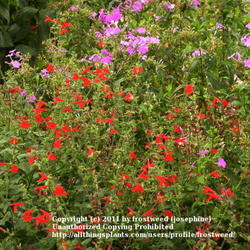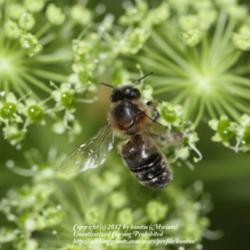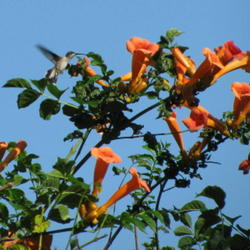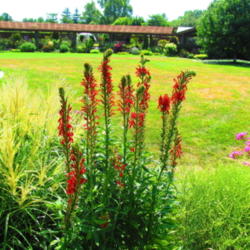There are certain flower traits that pollinators favor. By learning about them and by growing the plants with these traits in your own garden, you will increase the likelihood that you will atract pollinators yourself. For example: Hummingbirds seek red flowers, bees favor yellow and blue hues, and butterflies love bright-colored flower clusters and tubular flowers with plenty of nectar and a place to land.
Bees, butterflies, hummingbirds, and other pollinating insects will likely pass by your prized hybrid flower boasting big double blooms and head straight for the less elaborate native flowers. Many cultivated flowers, such as double-bloom varieties, are bred to look beautiful, but too many petals will get in the way and likely block the insects' access to any nectar or pollen. There are also other factors that might cause cultivated varieties to be ignored by pollinators. Some flowers lose their scent, making them undesirable to butterflies and bees, for example, or they might become sterile and no longer require pollination.

|
Wildflower species are native or naturalized plants growing on their own, without cultivation or assistance. Many pollinators are also native to the area and will seek out plants that grow in their natural surroundings. It's part of nature's plan: Wildflowers and pollinators need each other to survive. Most wildflowers require the assistance of pollinators to produce seeds and fruit. The pollinators need food. Wildflowers offer the optimal nutrition and habitat for the pollinators.
Another plus side to growing your region's wildflowers is the fact that they already have adapted to your specific climate and growing conditions, making them low maintenance. They are also often resistant to diseases and pests.

|
|
Hairstreak butterfly on Naked Mexican Hat |
Butterflies are a welcome sight as they flit or glide from flower to flower in search of nectar. They are attracted to scented flowers in bright colors, such as red, yellow, orange, and purple. Butterflies have long tongues, so they enjoy tubular flowers or spurred flowers holding nectar. Butterflies also prefer big flowers where they can land while nectaring. Daisies, Coneflowers, Milkweed, and Rudbeckia hirta are a few of the butterfly's favorite flowers.
Bees - All bees enjoy the nectar of wildflowers. There are honey bees, of course, and there are the bumble bees. There's also a large number of native bees. For the most part, bees like flowers that produce both nectar and pollen.
Bees don't see red, so they prefer flowers in shades of blue, purple, and yellow. Bee balm, Monarda fistulosa, is loved by all bees and it is native to virtually all of the United States and Canada. Lupines are a bumble bee favorite, and clovers such as Trifolium repens and T. incarnatum are loved by many bees. Some other bee favorites are Angelica, Foxglove, and Snapdragon. Native bees will be attracted by strong frangrances, and they also like flowers with lots of pollen, such as sunflowers (Helianthus annuus spp.).
Goldenrod species in the genus Solidago are a favorite fall flower of native bees and of many other beneficial insects. Many people mistakenly think goldenrod causes hayfever, but they are actually confusing it with ragweed (which is pollinated by the wind) because it grows alongside goldenrod. Goldenrod is pollinated by native bees and other beneficial insects. Ragweed is also loved by bees and other pollinators.

|

|
Hummingbirds are attracted to red-hued flowers and/or those with long necks. For some reason, many of the hummingbirds' favorite wildflowers are large or vining plants that might take up more room than you have available. If you are limited on space, Spigelia marilandica, salvia coccinea and Aquilegia canadensis are some favorites that won't need so much room in your garden. If you have plenty of growing room, Aesculus pavia and Malvaviscus arboreus or M. arboreus var drummondii are just a few good choices.

|

|
There are so many beautiful wildflowers producing both nectar and pollen that it is easy and rewarding to grow an attractive garden for both gardeners and the pollinators who grace their gardens. Plus, it's a great way to support the native insect population and a healthy ecosystem.
There are also many pollinators that aren't as popular and are often forgotten. The list includes ants, bats, beetles, ladybugs, flies, moths, and various wasps.
For example, this Hoverfly (Syrphid) is sometimes called "Flower Fly" and is often found hovering (how it got its name) over nectar and pollen flowers.
 |
|
Here's a list of some wildflowers that will attract bees, butterflies and hummingbirds alike, along with other pollinators and beneficial insects. This is just a short list of suggested wildflowers. Ideally, you will have a variety of continuous or overlapping blooms in your wildflower garden. Your region will determine which plants will grow best for you and your pollinating visitors. Look for wildflowers that are native or naturalized in your area. I've tried not to include plants considered by many to be "invasive," although I have learned that the mere presence of a plant's name on a list of invasive plants doesn't mean it will be invasive in my area. I've also had plants grow like crazy, even though these plants weren't known to be aggressive at all. I've had similar experiences with plants listed as "easy to grow in a sunny position". Everthing depends on where the plant is growing. For me, "full sun" can easily mean the plant will do much better with afternoon shade.
Achillea millefolium, Common yarrow
Asclepias curassavica, Tropical milkweed
Asclepias spp., Milkweed
Campanula americana, American bellflower
Cephalanthus occidentalis, Common buttonbush
Dalea purpurea, Purple prairie clover
Echinacea purpurea, Purple Coneflower
Liatris spicata, Gayfeather
Lilium superbum, Tiger lily
Lobelia cardinalis, Cardinal flower
Lonicera sempervirens, Coral honeysuckle
Monarda, Bee balm
Phyla nodiflora, Turkey tangle frogfruit
Salvia farinacea, Mealycup sage
Salvia lyrata, Lance leaf lyrata
| Thread Title | Last Reply | Replies |
|---|---|---|
| Wonderfully done Christine!! by frostweed | Sep 12, 2017 7:50 AM | 8 |
| Great Article! by vic | Aug 19, 2013 6:17 AM | 5 |